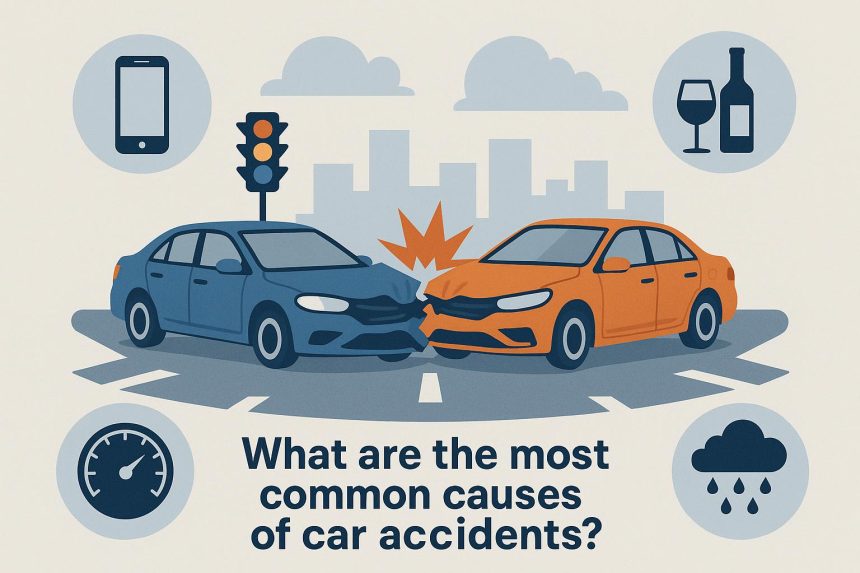Long Island’s busy roadways are essential arteries connecting its neighborhoods, beaches, and suburban communities. But with that constant flow of traffic comes increased risk. The region’s mix of commuters, commercial trucks, and weekend travelers often results in congested conditions and unpredictable driving behavior. For residents and visitors alike, understanding the reasons for car accidents in Long Island is vital.
From distracted driving and speeding to poor weather and road rage, the causes of crashes are often preventable. Knowing these risks can help drivers stay alert and make better decisions behind the wheel. When accidents do happen, the consequences can be life-altering, and liability is rarely straightforward. In these moments, a Long Island car accident lawyer plays a crucial role in helping victims navigate insurance claims, medical bills, and legal options to pursue compensation and accountability after a crash.
Distracted Driving
Distracted driving is one of the most common causes of collisions. Texting, eating, or changing the radio can distract you from the road and reduce reaction time, increasing the chances of a collision.
The solution to distracted driving is simple: keep your eyes on the road. This includes not having phones in reach and setting up navigation before you start driving. These simple practices can immensely lower the odds of accidents.
Speeding
Speeding is also one of the most common causes of road accidents. The faster the speed, the slower a driver can respond to an unexpected change, such as the appearance of an obstacle or the arrival of a traffic light. Moreover, injuries from a crash are more severe at a higher speed.
You should adhere to speed limits and drive according to the weather and traffic conditions. Driving slowly helps drivers respond and react in a better way, contributing to safety.
Driving Under the Influence
Alcohol, drugs, or other controlled substances can negatively impact your coordination and judgment. This makes driving under the influence a dangerous decision, as drivers cannot make decisions quickly and are prone to safety risks.
All drivers should plan to use alternate transportation if they will be using substances that may impair their ability to drive. Public transport or a designated driver can save lives.
Weather Conditions
Adverse weather conditions, such as rain, fog, and ice, can significantly affect driving conditions. Tires have lower traction on wet or icy roads, which raises the potential for losing control. Fog reduces visibility, making it difficult to notice other vehicles or road signs.
Drivers should reduce speeds and increase following distances to safely maneuver in rough weather conditions. Turning the headlights on to help with visibility and ensuring the tires are in good condition can help drivers safely reach their destinations.
Running Red Lights
Ignoring traffic rules can lead to fatal accidents. Many red light violations cause high-speed crashes at busy intersections. To avoid these incidents, drivers should remain attentive to traffic lights and other signal changes. When the lights switch to yellow, the rule of thumb is to err on the side of caution and be ready to stop.
Tailgating
Tailgating is a risky maneuver that doesn’t leave much margin for error. If, however, a vehicle comes to a stop in front of you, a collision is nearly unavoidable. The best way for drivers to avoid tailgating behind another vehicle is to stay back. Some guidelines include the “three-second rule,” which states drivers should maintain a following distance of at least three seconds to give them ample time to respond in case of sudden halts.
Fatigue
Driver fatigue can be as dangerous as impairment. Tired drivers will have a slower reaction time and will also be more likely to fall asleep at the wheel. Long journeys can be exhausting, and drivers should make sure they are well rested beforehand and take breaks.
Conclusion
You can drive more safely when you are aware of the most common reasons for car accidents. This includes keeping your eyes on the road, adhering to traffic rules and speed limits, making sure your car is in good shape, and not driving under the influence. By taking these precautions, drivers can make roads safer for everyone.
Lynn Martelli is an editor at Readability. She received her MFA in Creative Writing from Antioch University and has worked as an editor for over 10 years. Lynn has edited a wide variety of books, including fiction, non-fiction, memoirs, and more. In her free time, Lynn enjoys reading, writing, and spending time with her family and friends.















